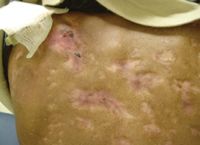- General Dermatology
- Eczema
- Chronic Hand Eczema
- Alopecia
- Aesthetics
- Vitiligo
- COVID-19
- Actinic Keratosis
- Precision Medicine and Biologics
- Rare Disease
- Wound Care
- Rosacea
- Psoriasis
- Psoriatic Arthritis
- Atopic Dermatitis
- Melasma
- NP and PA
- Skin Cancer
- Hidradenitis Suppurativa
- Drug Watch
- Pigmentary Disorders
- Acne
- Pediatric Dermatology
- Practice Management
- Prurigo Nodularis
Article
Worth the wait: Diagnosing difficult cases sometimes takes years
Despite nearly 20 years of waiting, a difficult case is diagnosed as the rare PAPA syndrome. After treatment with biologic anti-tumor necrosis factor (TNF) drugs, the patient's skin is now clear.

Key Points

At age 6, a now 22-year-old black patient presented to Wesley Galen, M.D., clinical associate professor of dermatology at Tulane University Health Sciences Center, with recurrent pustular nodules, which appeared as infectious suppurative abscesses, according to Erin Boh, M.D., Ph.D., professor and chairman of dermatology, Tulane University Health Sciences Center.
Symptoms

The faculty at the time treated the patient with sulfa-type antibiotics, but his blood counts would drop. He had chronic low white counts.
"From age 6 until puberty, the boy had multiple hospital admissions for recurrent skin abscesses and swollen joints," she says.
Over the years, the patient was repeatedly evaluated for immunodeficiency, including chronic granulomatous disease of childhood.
Doctors would study his white cells to see if the cells were not functioning properly and were immunologically compromised, but they never found a source of immunosuppression.
"He continued to have these abscesses and arthritis, as well as sterile osteomyelitis," Dr. Boh tells Dermatology Times.
As a teen, the patient started to develop horrible acne, which would occur in cycles along with these nodular PG-like lesions on his chest, back and extremities.
A 'new' syndrome
Dermatologists started looking for other causes and sent him for work-ups to immunology, pediatrics and hematology, and for more tests in dermatology. Doctors discovered, when the boy was 17 years old, that his father had a history of similar lesions, including the acne and abscesses.
He was admitted for pyoderma gangrenosum (PG) and a swollen knee in 2006. He was treated with infliximab, an anti-tumor necrosis factor (TNF) biologic agent, and his skin lesions and joints cleared.
"We started looking in the literature for an entity that would describe recurrent pyoderma gangrenosum-like skin lesions, pyogenic acne and sterile arthritis and osteomyelitis.
"There was a 'new syndrome' first described in 1997 and later reported in two other families worldwide. It is PAPA syndrome, one of the proinflammatory syndromes," Dr. Boh says.
PAPA syndrome is an autosomal-dominant disease, with pyogenic arthritis, pyoderma gangrenosum and acne. There are only three families reported worldwide with this syndrome.
Dr. Boh says that while the diagnosis took nearly 20 years, the patient's rapid response to anti-TNF drugs pointed to an inflammatory T-cell process.
People who have PAPA syndrome have no tolerance to sulfa medicine. They have pyoderma gangrenosum-like lesions as children, and, in puberty, they develop necrotic pyogenic acne.
Throughout their lives they suffer with arthritis as neutrophils collect in their joints, creating hot, sterile joint abscesses that look like rheumatoid arthritis.
"This PAPA syndrome is one of several syndromes reported in a group of diseases called proinflammatory, so it is not technically an autoimmune disease, like rheumatoid arthritis.
"A mutated gene may be responsible for the pro-inflammatory state. The body does respond to this massive proinflammatory state and upregulates all the neutrophils and causes them to generate free radicals, which sets off this whole inflammatory cascade," Dr. Boh says.
The diagnosis became possible once it was reported and T-cell technologies began to improve with drugs that would tweak the immune system and change how T cells work, she says.
Dr. Boh and colleagues treated the patient with biologic anti-TNF drugs, specifically, infliximab (Remicade, Centocor) and, currently, with adalimumab (Humira, Abbott).
Results
"This (man's) skin is clear today. He has had minimal flares of arthritis and PG eruptions on his skin. His acne is clear. He is basically normal for the first time in his life," Dr. Boh says.
"Prior to treating him with Remicade, he would get admitted to the hospital, easily, every couple of months. In the last two years, he has had only one admission for a flare. He is smiling. It is really cool," she says.





